Wicked coastal-trail progress thanks to Sir Peter
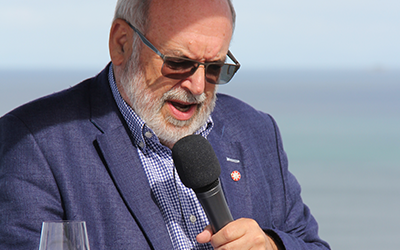
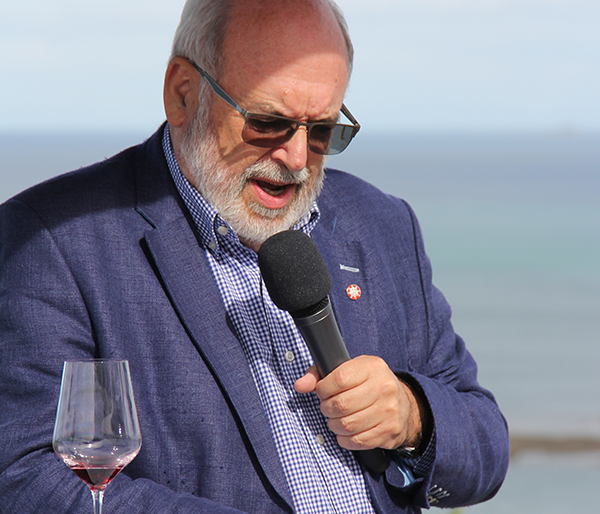
Wicked Connection: Shamelessly trading on his connection as founding director of the Liggins Institute, the Mahurangi Coastal Trail Trust succeeded in hooking New Zealand’s inaugural chief science advisor to the prime minister, Distinguished Professor Sir Peter Gluckman, as guest of honour at its first Mahurangi Coastal Trail charity cocktail party. Professor Sir Graham Liggins established his vacation residence in Ōpahi, and was legendarily responsible for the bay’s dominance over rival Jamieson Bay, in the two bays’ annual fishing competition. On 21 November, it was Sir Peter who did the hooking, of 90 guests inspired by his informed vision for the future. photographer Maree Owston-Doyle
Sir Peter was reluctant, he said, to use the term wicked problem, lest it imply insolvability. He did allow that addressing climate was very difficult, otherwise it would already have been.
Speaking at the Te Muri Crossing charity cocktail party, Distinguished Professor Sir Peter Gluckman might equally have been speaking about establishing the Mahurangi Coastal Trail, 35 years in the making. As with curtailing fossil-fuel use to salvage a survivable climate, linking 1000 contiguous hectares of regional parkland with a coastal trail appears, at first blush, to be an imminently desirable and readily achievable objective. A coastal trail is not, of course, an existential imperative, but what it might catalyse, arguably, could be.
In 2006, Sir Peter, with Professor Mark Hanson, published Mismatch – Why Our World No Longer Fits Our Bodies, which warns of the triple pandemics of diabetes, heart disease, and obesity, but provides uplifting examples of interventions that could avoid health systems, in ensuing decades, being overwhelmed, and billions of lives being blighted or worse. The noncommunicable pandemic of obesity has proved to be impervious to most interventions, but as non-commonsense as it may sound, public transport does make a significant difference, most probably because of the little bit of extra walking that is entailed.
The fact that cities can’t fit enough roads to road-build their way out of traffic congestion should, by itself, be reason enough to embrace public transport. New Zealand’s metropolis, after coming-up 42 years of world climate conferences, is on the cusp of deciding on a second, public-transport-only, Waitematā Harbour crossing. The September poll that had 66% of Auckland respondents favouring a combined road and rail tunnel and only 14% wanting a light-rail-only tunnel, perfectly illustrates the wicked problem—of just how ill-equipped the representative democracy model is for solving long-term problems. A government, or council, has everything to lose and little to gain by making informed-futures decisions on behalf of the next 10 or so elected administrations.

Wickedly Well-Qualified: Historian and philosopher of science Dr Tatjana Buklijas, with her background in epigenetic medicine—in common with Distinguished Professor Sir Peter Gluckman—heads an exploration of a suitable model of deliberative democracy for Aotearoa. While the connection might not be apparent, the often-inexpensive interventions that can break the chain of the epigenetically rooted pandemics, such that of obesity, are fatally short-changed by short-termism. image Central European University
Tweaking the electoral term from three to four years will not meaningfully address short-termism, and will have the negative consequence of making it that much harder to increase youth involvement in representative democracy. Three years is a lifetime for the about-to-be 18-year-old who narrowly misses a general election, much less four, or the United Kingdom’s five, years. If voters accede to the unabashed enthusiasm of politicians to vote themselves more power through a longer term of office, the people will have that much less power with which to demand a deepening of democracy. The electoral reform that introduced to Aotearoa the most scrupulously proportional form of representative democracy on offer worldwide, was unique:
While there have been two other instances where elite–mass interaction within established democracies resulted in substantive changes to their houses of representatives, the change was to less proportional systems.
Meantime, regardless of term-of-office, few democracies have managed to defeat short-termism. Institutions such as that founded by Sir Peter Gluckman 2019 and renamed Koi Tū – The Centre for Informed Futures in February, potentially can provide, independent of the electoral cycle, the long-term policy ballast to counter the inevitable populistic squalls of short-termism. The Centre for Informed Futures, in fact, goes further, addressing the dire deliberative democracy deficit that Aotearoa shares with even its most democratically inclined peers. The centre has begun an exploration of what a model for New Zealand’s deliberative democracy might look like. Ireland’s experience in this area often cited, but, by its 42 times higher covid-19 infection rate, that country singularly failed to deploy the device when it might have helped save thousands of lives.
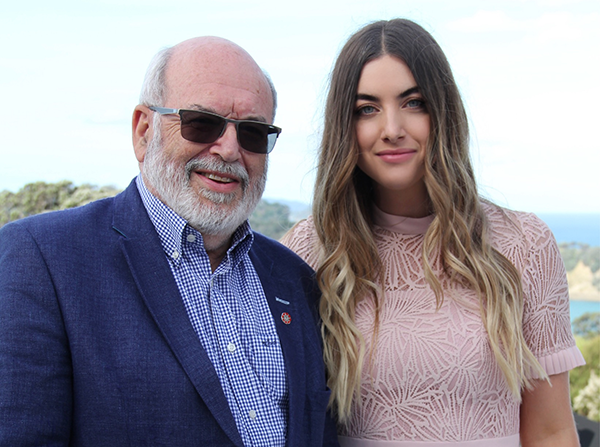
Wicked Woman: When Distinguished Professor Sir Peter Gluckman referred to “that magnificent woman who spoke earlier”, 90 Te Muri Crossing charity cocktail party guests instantly knew he was referring to Tessa Berger. Four years earlier, the Junction magazine described the wickedly accomplished then 21-year-old athlete, Auckland Council local board member, entrepreneur, and chair of the Mahurangi Coastal Trail Trust as an uber-human. The fatal flaw in the instinct to prolong political terms of office is that entire cohorts of potential young leaders miss the opportunity to become representative at a sufficiently young age to inspire their peers to vote for them. photographer Maree Owston-Doyle
Although addressing the deliberative democracy deficit is inexcusably overdue, given New Zealand’s place in history as the world’s first full democracy, the linchpin for engaging New Zealand’s in electoral reform is its deficit in direct democracy. If one of the 2020 referendum questions had been on whether results should be binding, the response, born of countless referendums ignored by governments, would be thunderous. In the blunt form in which they generally are used in Aotearoa, and in most jurisdictions, it is as well that they are not binding. But most referendums arguably should be, provided they are part a well-rounded process of democracy that includes deliberative, participatory, and of course, representative, democracy.
Aotearoa, in common with most Western democracies, possibly spends more on participatory democracy than on representative democracy. The consultation involved in producing Auckland’s thousand-page unitary plan was famous for sapping the resolve of many of the ordinarily most conscientiously engaged citizens. It is small wonder that non-Pākehā were grossly underrepresented among the 26 000 who did attempt to engage in the development of the plan. If it was known how much was spent to participatory democracy each year, perhaps there would be a far greater determination to ensure it consistently made a positive difference. At least Aotearoa knows that its general election cost around $100 million, whereas in the United States:
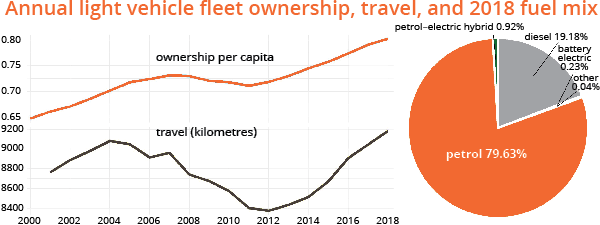
Wicked Ways to Go: While planting trees in them would appear to be the most pertinent response of the regional parks of Tāmaki Makaurau to the climate emergency, providing other-than-light-vehicle-access to them will both directly and indirectly make a more meaningful emissions contribution, but will also address multiple other issues, including mental and physical wellbeing. graphicMahurangi Magazine | data Ministry of Transport
Elections aren’t priceless—it’s just that no one has put a price on them yet.
But rather than seeking to reduce the annualized cost of holding elections by 25%, by holding them only once in four years, holding elections annually without the circus, and with increasing numbers e-voting can, with a little effort, be envisaged as both less expensive and greatly more engaging of youth—and infinitely less corruptible, as the Chartists only unimplemented reform stated:
6. Annual Parliaments, thus presenting the most effectual check to bribery and intimidation, since though a constituency might be bought once in seven years (even with the ballot), no purse could buy a constituency (under a system of universal suffrage) in each ensuing twelve-month; and since members, when elected for a year only, would not be able to defy and betray their constituents as now.
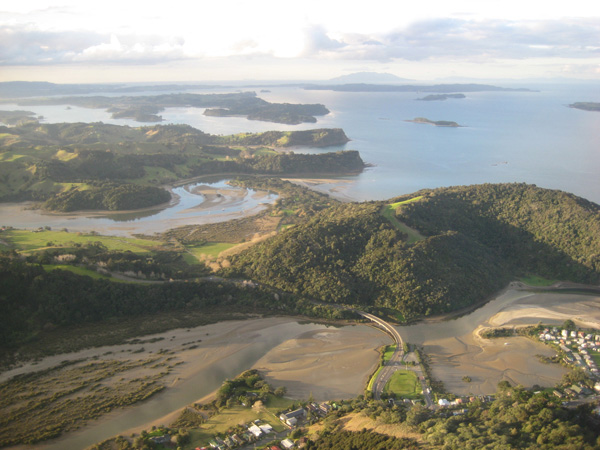
Wicked Mahurangi Coastline: If any section of the Tāmaki Makaurau coastline can soften the heart of the most unrepentant neoliberal, the first great stretch of unbuilt coastline north of the metropolis, from Waiwera northward might. For anybody else even halfways aware that the only home of Homo sapiens sapiens, and every other beautiful fellow lifeform, is being put to the spear of short-termism, the sense of splendid isolation of Te Muri and its sheltering 1000 hectares of regional parkland can provide the place to resolve to fight for more than halfway informed futures. image ImageShack
Writing for The Guardian, Geoffrey Wheatcroft points out that elections don’t need to involve enormous sums of money spent by parties, without which, democracy would be much better off.
The wicked progress being made on the Mahurangi Coastal Trail is the result of the fiwwpfi“bother it, we will pay for it” doctrine that dodged the brick-wall of pre-covid-19 council austerity, and leapfrogged the brick wall post–covid-19 council austerity——applied to the estuary crossing already sanctioned by the regional parks management plan, and by Ngāti Manuhiri. It is a model that combines bicultural deliberative democracy with post-Neoliberal pragmatism—but Te Muri Crossing Doctrine or nay, it is the 1000 contiguous coastal hectares of Mahurangi regional parkland, and the prospect of traversing it on foot, with no adjoining road to diminish the experience, that sells the Mahurangi Coastal Trail to everyone who contemplates its prospect. In turn, the Mahurangi Coastal Trail, with its cross-Mahurangi Harbour ferry, will create one of the great walks of Aotearoa, and guarantee the societal and economic viability of the greater Mahurangi coast trails network.
For a country with 100% Purethe much-derided, M&C Saatchi-conceived, 100% Pure New Zealand tourism campaign at odds with environmental degradation exacerbated by the contemporaneous dairy industry “white goldrush” pretentions, New Zealand’s near 100% light vehicle ownership rate is an aberration that can’t be ev-ed away, much as it might suit Elon Musk’s narcissistic narrative for that to go unchallenged. Walking the great Mahurangi coast trial, for most, will involve two things: walking a comfortable day or half-day section; and using public transport to square the circle. This contrasts starkly with the cardinally car-centric model on which the Auckland Regional Parks network was conceived. Come the climate emergency, however, the new management plan is required to show regional parks playing their part in greenhouse-gas-emission reductions. Tāmaki Makaurau’s regional parks are perfectly positioned to do much than sequester a little more carbon and virtue signal for an uninformed ev future—Makaurau’s 44 000 hectares of regional parkland are the perfect place to showcase informed futures, on the doorstep of 1.5 million New Zealanders.
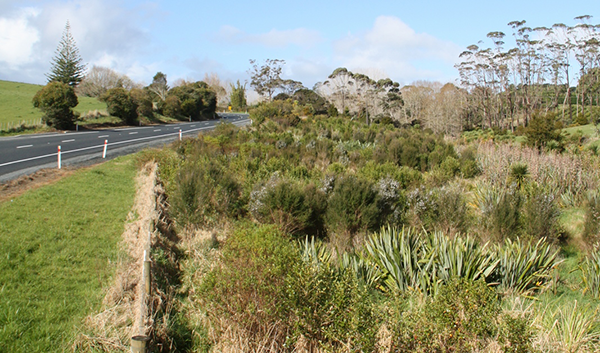
Wicked World-First: In what was certainly a world-first in Aotearoa, but very possibly a world first full stop, the establishment performance of indigenous species typically used for revegetation was trialled, comparing plants raised by three different nursery methods, one being forestry-style. The trails showed that plants raised in open-ground nursery beds, à la radiata pine, established as well as those raised by the up-to-10-times more expensive horticultural methods, in containers. Subsequently, the trials were further replicated in the Lake Taupō catchment, with similar results. Incredibly, lacking any sort of informed-futures ethos, the work was ignored by the New Zealand First party’s “billion trees” initiative. The trial site, on private land beside Sandspit Road, is uncharacteristically accessible, including because it is part of farm-forestry trail available to the public. Such trial-site accessibility is rare, hence the sublime opportunities presented by regional parkland. image Michael Bergin
While any one of the 27 namedMahurangi Action’s submission on the Te Muri management plan variation argued for consolidating the three contiguous named Mahurangi regional parks as one Mahurangi Regional Park, which would reduce the count to 25 regional parks makes for an informed-futures showcase, the greater Mahurangi regional park has the magnificent distinction of marking the beginning of the first great stretch of unbuilt coastline north of the metropolis. If, as Sir Peter indicated, even short walks amidst nature are therapeutic for mental wellbeing, the Mahurangi coast is a veritable sovereign remedy for the psyche. Or at least it would be, but for the cognitive dissonance induced by the knowledge that business as usual is condemning coastlines to multi-metre sea-level rise, and the regional parkland to drastically diminishing biodiversity. If, however, the parkland showcased informed futures, such as planted indigenous forestry at scale and in a manner that can be affordably replicated on private and Māori land, a journey through it could be magnificently uplifting.
For the first 500 years of Polynesian occupation, and the next 150 of shared Māori–Pākehā settlement, the Mahurangi was traversed primarily via its coastline. All-weather roads, and the end of the steamboat era, date only from the 1930s, yet for most park visitors, access to the coastline involves a schizophrenic darting between highway and coast, with few opportunities to experience it as Māori clearly did, longitudinally, on foot or aboard waka. It is strongly in New Zealand’s self-interest to be selfless about playing to its strengths; to its geological, geographical, and cultural uniqueness. New Zealand’s uniqueness includes: last significant habitable landmass to be geologically formed; the last to be peopled; the last to be colonised. Aotearoa can also boast and wealth of firsts, not least of all being the world’s first full democracy—by including indigenous men, then women, in universal franchise.
By prosecuting a zero-carbon action plan to the nth degree, Aotearoa, by itself, cannot avert runaway global warming. However, by demonstrating meaningful, exportable interventions, as part of its unique narrative, Aotearoa might, just. It is in New Zealand’s blatant self-interest to lead the charge back to a survivable climate and global sustainability, democratically. Likewise, in microcosm, it is blatantly in greater Mahurangi’s self-interest to pitch itself as the informed-futures exemplar for Aotearoa. Meanwhile, the scale of the reforestation required to address the elevated sediment-accumulation-rate that plagues the Mahurangi Harbour cannot be reversed by community planting days. But by playing to the Mahurangi harbour and coast’s natural strengths—location, location, location—and making the Mahurangi a veritable informed-futures showcase, critical mass could be created.
A wickedly mobilising informed-futures alternative, to wicked-problem despair.
Wicked waste Antonio Guterres describes the collective failure to address the wicked problem as suicidal, and urges that recovery from the covid-19 pandemic is humanity’s chance for a reset to salvage a survivable climate. Suicidally, every indication is that the covid-19 crises will be just the latest global crisis to be wickedly wasted, not least of all as the spur the immediate, radical reform of the patently unfit-for-purpose United Nations.
Put Te Muri Crossing high tea in your own calendar
